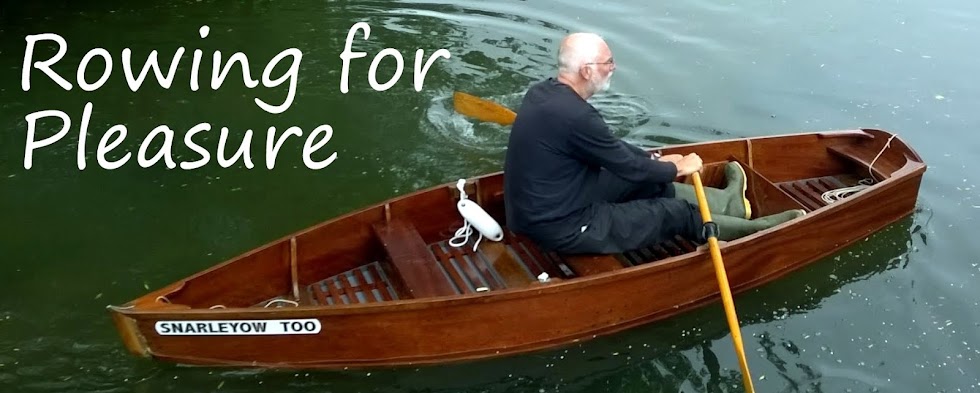Once again, Kim Apel reports from a fabulous location for rowing, this time British Columbia where he is pictured in an Adirondack Guideboat. The Guideboat has legendary rowing qualities that I was always a teeny bit sceptical about, but Kim reports that it delivers. Of course, it might not be the boat - he could have been the fittest guy on the water, or rowing could be intrinsically faster than paddling. You decide:
Chris: I thought you might like a trip report from the far west. I was part of a group of six preparing for a wilderness canoe trip in Canada.One dropped out, leaving two canoe-pairs and me, the odd man out. So I borrowed an Adirondack Guideboat, and found rowing solo, rather than paddling tandem, to be a wonderful option. Remarkably, the 14 ft. hull easily kept pace with a pair of longer, sleeker, lighter performance canoes. It’s faster than it ought to be for its length.
We were in Wells-Gray Provincial Park in the Cariboo Mountains of British Columbia. There is no road access to 25 mile-long Murtle Lake. One must portage boats and gear 1¾ mile to the water’s edge. The lake is restricted to “paddle-only,” though oars seem to be acceptable as well.
Google Adirondack Guideboat for background on this 19th century American type. Note the unusual bottom shape of the Guideboat hull. Though the photo is of a Kevlar-composite hull, the shape reflects the design of the traditional wooden hull, which included a substantial flat keel-plank or backbone, to which very light ribs and topside planking were attached.
Kim Apel
San Clemente, California, USA

3 comments:
Thanks for sharing with us, Chris! And Kim, looks like you had a super adventure !! (I hope you and your friends have many more photos that you can share with us !!?)
Looks like a lovely and very typical British Columbia Wilderness-Lake experience. Enhanced by the Gov't enforced "no-motors" (not even electric) policy. Quiet. The experience of this environment is virtually indescribable. But Myrtle is not a beginners lake. In BC, few of the wilderness lakes are.
I have heard that Myrtle lake is considered the largest Motors free eco-reserve lake in North America.
A 14-foot boat will cruise under oars easily at about 4-6 knots, with little stress on the oarsman, while a paddler would be having his arms falling off in fatigue in short order. A matter of leverage. For the Adirondack, if I were to use one a lot, I might like to see if some light out-rigged row-locks can be intalled, to improve the leverage on the oar-load.
I am glad to see, Kim, that you found a modern construction hull. In the back-of-beyond I would have more confidence that it would stand up to any outrageous fortune, collisions with dead heads, etc, that in a traditional build may need some serious emergency wood butchery and Duck-tape repairs just to limp out.. The fibre composites can be bunch heavier, but more durable and forgiving of a drop off the dolly or transport-cart, and so on.
Blessings,
Robert
Chris- I can vouch for the performance of a guide boat- I have rowed one in the States and own a Vermont Fishing Dory made by the same company that built Kim's Kevlar guide boat by the look of it. The Vermont Dory is a slightly more spacious/stable derivative design and she flies for her size- when I am out fishing in her off Kent she will leave any kayak dead in the water. She is a kevlar composite too and is the same weight as the wooden version- but more suited to life on the shingles of the south east. My own (wooden) guide boat is being built as I type by a friend in BC- as soon as she is finished I will send photos...
the Adirondack is lovely, but as Rob points out rowing beats paddles every time.
I've been looking at a few canoes and even sit on kayaks (especially the fishing ones)which would seem ideal for conversion to rowing. Could be winter project coming up.
Post a Comment